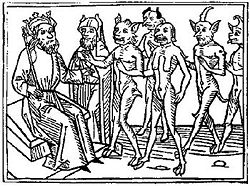This article includes a list of general references, but it lacks sufficient corresponding inline citations .(August 2023) |

In this article, the demons' names are taken from the goetic grimoire Ars Goetia , which differs in terms of number and ranking from the Pseudomonarchia Daemonum of Johann Weyer. As a result of multiple translations, there are multiple spellings for some of the names, explained in more detail in the articles concerning them. [1] [2] The sole demon which appears in Pseudomonarchia Daemonum but not in the Ars Goetia is Pruflas.
Contents
The 72 angels of the Shem HaMephorash are considered to be opposite and balancing forces against these fallen angels.



























